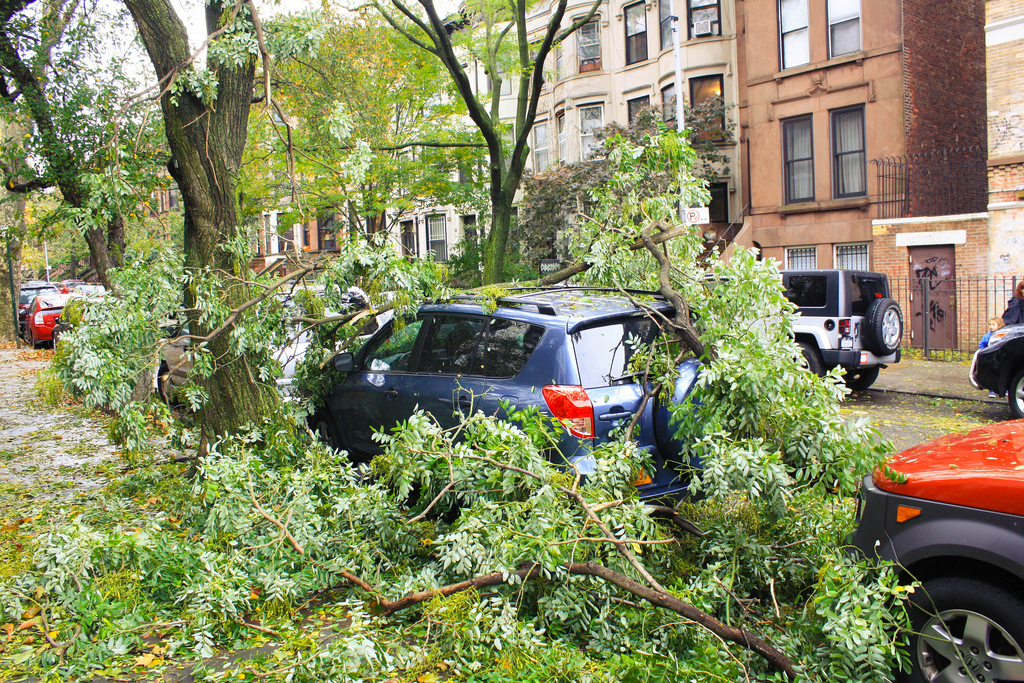
In New York City, where neighborhoods function as self-contained ecosystems linked by public transportation, being in a pocket that was mostly unscathed by Superstorm Sandy was a lucky, and bizarrely insulating, experience. When the winds roared into town on Monday night, shuttering subways, buses, roads, and bridges, my husband and I spent the worst hours of the storm eating peanut butter and jelly sandwiches, drinking beer, and watching storm footage on television. The lights never went out, and our dog slept through it all.
Our quiet residential street in South Park Slope, Brooklyn revealed nothing of the apocalyptic scenes playing out just a few miles to the north and south in Lower Manhattan and the Rockaway peninsula in Queens. A brief tour the next morning revealed some downed trees, broken fences, and damage to a few storefronts. Nothing felt dangerous until we saw the reports: the crane teetering over West 57th Street, the Con Edison plant exploding as half of Manhattan went dark, the devastating fires that decimated more than 100 homes in Breezy Point, a row of ambulances lined up to transport patients from a powerless hospital, and this haunting photo of water submerging the carousel in Brooklyn Bridge Park, just a few stops from my apartment on the now-defunct subway.
Before moving to New York, I spent almost seven years in Southern California, where every summer and fall seems to bring wildfires. Residents in the flats go about their business unaffected apart from breathing in the smoke and ash, but a half-hour to the north, thousands of residents are getting displaced. One night, when I drove into Los Angeles from the east, the air was searing, and the only thing I could see in the dark on either side of the 10 Freeway were the mountains, which had become glowing infernos.
Californians exhibit a preternatural composure in the face of natural disaster (although of course it only takes a half-inch of rain to invoke total chaos), and over time I too developed a certain nonchalance about the prospect of fires, earthquakes, and mudslides. Danger, from a distance, often looks more dangerous than it does up close. People outside of Mexico might think the country is unsafe, while people inside Mexico think only Juárez is unsafe. Los Angeles looked deadly during the L.A. riots, but most Angelenos just watched them on television.
Then again, maybe distance makes us more, not less, realistic: I could have suffered the fates of unluckier fellow New Yorkers. I was just geographically lucky once more. My personal theory about being caught in the direct path of a natural disaster is similar to the one I hold about airlines losing luggage—the fact that it’s never happened to me means that I’m overdue.
When I’m no longer watching on from nearby—when it’s my turn to face a fire or flood—I hope that I respond with the grace, humanity, and stalwartness displayed by the first responders, medical personnel, and so many of the residents of New York City and the Northeast coast. But for now, as millions of people continue to wait out the darkness and water, my ecosystem thrums with everyday activity. People have been shopping, dining, walking their dogs, and trick-or-treating. With the fragile connectors that link the disparate boroughs and neighborhoods of New York City broken, we find ourselves planted on an island within an island. It’s a surreal ordinariness that brings palpable relief combined with a kind of survivors’ guilt.
Not that I fault anyone for returning quickly to old routines. It’s not callousness that drives us to carry on while others are suffering. Who wouldn’t want to return to work, make a morning coffee run, or dress the children up as superheroes to go out and collect candy like any other October 31? In any place, and under any circumstances, the human desire to reclaim normalcy may be the strongest force of all.




Send A Letter To the Editors